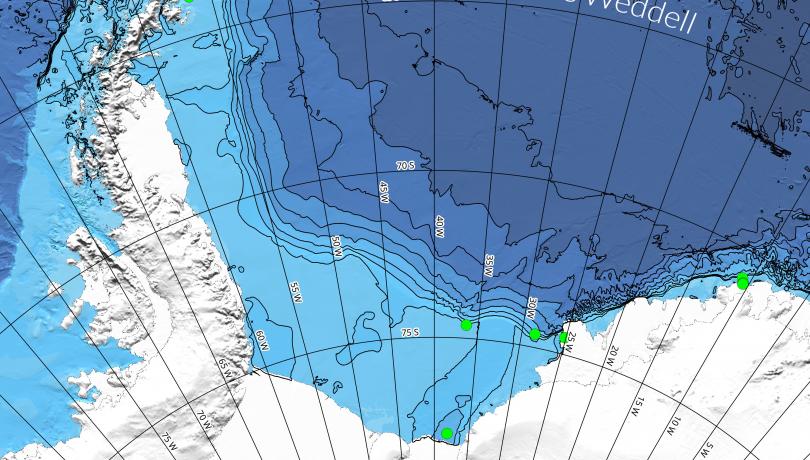Industrial activity generates harmful substances that can reach the most remote places on the planet, transported by winds and ocean currents. A new study conducted by the Institute of Marine Sciences (ICM) and the Institute of Environmental Diagnosis and Studies of Water (IDAEA), both centres of CSIC, has detected cellular toxicity produced by anthropogenic-compounds in Antarctica seabed. Samples of Antarctic sediments come from several stations along more than 4,000 kilometers from the Weddell Sea and off the coast of the Antarctic Peninsula.

Industrial activity generates harmful substances that can reach the most remote places on the planet, transported by winds and ocean currents. A new study conducted by the Institute of Marine Sciences (ICM) and the Institute of Environmental Diagnosis and Studies of Water (IDAEA), both centres of CSIC, has detected cellular toxicity produced by anthropogenic-compounds in Antarctica seabed. Samples of Antarctic sediments come from several stations along more than 4,000 kilometers from the Weddell Sea and off the coast of the Antarctic Peninsula.
Finding compounds from human activity in these remote and apparently isolated regions is striking. Although since the 1970s there is evidence of the presence of anthropogenic contaminants in the Antarctic food chain, this study indicates, for the first time, that at the bottom of the Antarctic ocean, hundreds of meters deep, there are compounds generating cytotoxic activity related to with the presence of organic pollutants.
In the study, led by Enrique Isla, from the Institute of Marine Sciences of the CSIC, scientists have worked with sediment samples obtained from the Antarctic bottom in several campaigns with the German icebreaker "Polarsten". Later, in ICM and IDAEA laboratories, they exposed cell cultures to the compounds extracted from the sediment and have observed cell toxicity and a cellular metabolism related to detoxification of contaminants, which allows to deduce that there are contaminants in the samples.
Cell toxicity
 Sediment extracts with greater cytotoxic response coincide with the places that have the greatest human presence, such as the Antarctic Peninsula, where the majority of scientific bases are located and there is frequent maritime traffic. However, the sediment extracts from the East Weddell Sea did not generate significant toxic responses, which coincides with areas that are less exposed to contamination.
Sediment extracts with greater cytotoxic response coincide with the places that have the greatest human presence, such as the Antarctic Peninsula, where the majority of scientific bases are located and there is frequent maritime traffic. However, the sediment extracts from the East Weddell Sea did not generate significant toxic responses, which coincides with areas that are less exposed to contamination.
Likewise, cytotoxic activity was detected in marine sediment from very deep areas of the ocean, more than 1000 meters deep. "At great depths, low temperatures and light absence greatly limits the degradation of pollutants. Also, there is no way to isolate or clean them. Their destination is to accumulate on the Antarctic seabed, where many organisms live", says Enrique Isla, researcher at the Institute of Marine Sciences and author of the study.
Aquatic organisms, and in this case, those that inhabit the seabed, could be exposed to persistent anthropogenic compounds that have been detected in the sediment, and that could be incorporated into the trophic chain, reaching higher levels of the food pyramid, and could compromise the development of the affected organisms.
Antarctic seabed organisms
(thanks to Julian Gutt and AWI, Bremerhaven, Germany)
Impact similar than observed in Mediterranean Sea
Surprisingly, the results observed in the most impacted areas of Antarctica are similar to those in some coastal areas of the Mediterranean. The current study does not specify the sources of contamination or their chronological origin. This will require more accurate analysis. However, given the maritime traffic of these areas, scientists suggest that a large part of these compounds responsible for cell toxicity could be polycyclic aromatic hydrocarbons (known as PAH's), which come from the incomplete combustion of organic matter.
"This work opens new questions to investigate pollution sources more in detail, identificate substances, their abundance in the sediment and its impact on marine life," explains Isla.
The samples of Antarctic sediment were obtained in several campaigns aboard the German icebreaker "Polarstern", in cooperation with the German Institute Alfred Wegener of Marine and Polar Research of Bremehaven and co-financed by the Spanish Ministry of Economy and Competitiveness. The study counts with the collaboration of Elisabet Pérez-Albaladejo and Cinta Porte, researchers from the Institute of Environmental Diagnostics and Water Studies (IDAEA-CSIC), where the analyzes have been carried out.
Article: Toxic anthropogenic signature in Antarctic continental shelf and deep sea sediments. Enrique Isla, Elisabet Pérez-Albaladejo, Cinta Porte. Scientific Reports, (2018) 8:9154. DOI: 10.1038/s41598-018-27375-4. (link)